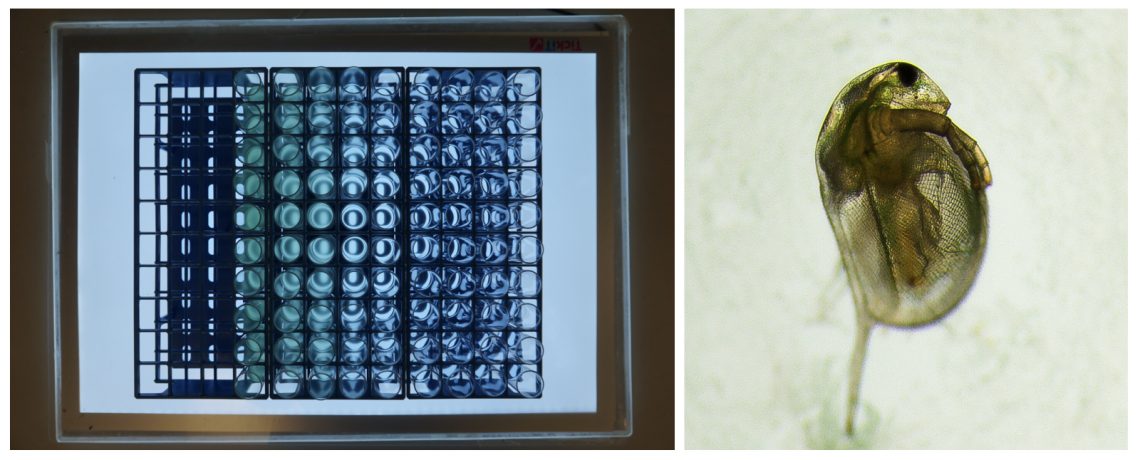New research shows invertebrates can be harmed by cyanobacteria

Algal blooms are becoming more and more frequent. Those blooms can be harmful for freshwater lakes and nearby ecosystems and communities. One of the dominant algae species in those blooms is a cyanobacteria named Microcystis. Cyanobacteria are also called blue-green algae and are so tiny, that you can only really see them under the microscope. Despite their size, they can have detrimental effects on organism and can cause death to humans, dogs, fish, birds, etc. Those negative effects are the result of a toxic substance belonging to the class of microcystins. Those harmful algal blooms are caused by eutrophication, often due to agricultural run-off. Climate change further increases the severity and frequency of those blooms.
In aquatic ecosystems, small invertebrates such as water fleas (Ceriodaphnia spp. and Daphnia spp.) feed on the blue-green algae. The water fleas themselves are prey organisms for several different other invertebrates and fish species and are therefore a keystone species in an aquatic food web. If they are negatively affected by toxins produced by the blue-green algae, the entire food web would potentially get disrupted. Even though Daphnia directly ingest the cyanobacteria, it is unclear how the toxic substance within the algae affects those water fleas. Previous research has shown inconclusive results, with some studies showing toxic effects resulting in increased mortality and population decline, whereas other studies showed no negative effect. René Shahmohamadloo and collaborators at the Ontario Ministry of the Environment were interested in testing the effects of toxic Microcystis on water fleas using a novel methodology. This novel methodology tests the toxicity of the blue-green algae in a way that mimics real life exposure to those toxins more realistically than older methods. René is a PhD student at the School of Environmental Sciences in Prof. Paul Sibley’s lab.
In addition to testing how water fleas respond to different levels of cyanobacteria exposure, René Shahmohamadloo and his collaborators were also interested in understanding how mayfly nymphs (Hexagenia spp.) are affected by the algal blooms. The mayfly nymphs live burrowed in lake sediments feeding on detritus. They are an indicator species for lake health, meaning that healthy lakes provide better living conditions for those mayfly nymphs.
The experiment was conducted in the laboratory. Water fleas and mayfly nymphs were exposed to different levels of cyanobacteria. They found that the mayfly nymphs were not affected by the exposure to the toxic algae. They speculate that the mayfly nymphs could either have reduced the negative effects by burrowing into the substrate and avoid the exposure, or by the fact that their larger size makes them more tolerant to the blue-green algae, at least shorter term. In contrast, the three water flea species showed high levels of mortality at a lower toxin levels compared to previous studies. They also found that all three species had different tolerance levels, with Daphnia magna having the least severe negative response.
This result shows that toxic algae blooms can negatively affect invertebrates at the bottom of food webs, with some species reaching 100% mortality at relatively low dose of the toxin. This could potentially lead to serious disruptions and changes within aquatic food webs during times of algae blooms.
Citation: Shahmohamadloo, R. S., Poirier, D. G., Almirall, X. O., Bhavsar, S. P., & Sibley, P. K. (2020). Assessing the toxicity of cell-bound microcystins on freshwater pelagic and benthic invertebrates. Ecotoxicology and environmental safety, 188, 109945.
You can find the original research article following this link: https://www.sciencedirect.com/science/article/abs/pii/S014765131931276X
If you have any questions about our research contact sescomms@uoguelph.ca and if you have specific questions about this article, contact René Shahmohamadloo directly via email: rshahmoh@uoguelph.ca